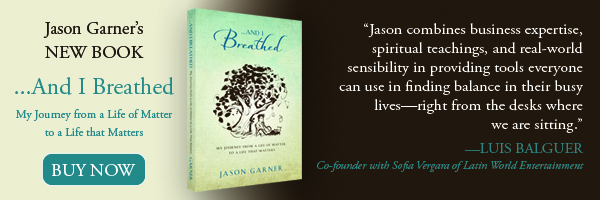Have you ever been in a meeting and, despite hours and hours of careful preparation, felt it slowly falling apart? Your breath shortens, your mind gets cloudy, and you start to feel all eyes in the room converging on you? You start to imagine the thoughts of the room, you see the other participants as judges, and before long you’re convinced that everyone is out to get you? I have … many times.
Whether it’s a corporate board meeting, a Monday morning gathering of your coworkers, or a negotiation with another company, we all, at one point or another, have a meeting that overwhelms us and causes us to get increasingly trapped in our brains as we try to think our way out of it. In therapy this is called fragmentation —the experience of getting so lost in our thoughts that we lose sight of our surroundings. In my life it’s been the genesis of many embarrassing moments of drama and conflict … the kind on which you reflect and can’t quite put your finger on where it all went so wrong.
Over the last several years of study with my teachers I’ve learned that you can’t think your way back from fragmentation — thoughts can’t solve it because the problem lies in our thoughts. So we have to learn to leave our heads and find our way to our hearts. This is counterintuitive in business because we’re taught to outthink the competition and associate the heart with weakness. While the brain is a useful tool, it’s also a double-edged sword that can often be detrimental when it’s the only tool we know. With that said, I’ve developed a toolbox to find my way home to my heart, a series of steps that I can use proactively to stay mindful; or, when that fails, as a fix to move from the obsessive spinning of my brain into the safety and wisdom of my heart.
1. Breathe. One of the first things that happens when we begin to feel stress or panic is that our breath shortens and the body enters a state of “fight or flight.” In this condition, much of our reasoning capability is overridden and we literally have only two options – battle or flee. This genetic response is very useful if you’re a caveman confronted by a hungry predator or an angry warrior. But what was designed to keep us alive in the jungle can often result in the death of a meeting or our career in the boardroom.
Early in my studies with Guru Singh, he taught me to recognize and override my genetic responses by slowing down my breath. This is done via controlled inhaling and exhaling to a count and cadence that signals to the body that all is well in the same way that short, rapid breathing tells the body that danger is at hand. The average person breathes about 12-16 times per minute. In stressful situations that increases exponentially, with panic levels above 24. When our rate of breathing increases, time seems to speed up and we get hyper-focused on whatever we are most fearful of. Soon it’s all we can think about or see and we act rashly from a place of panic. Through controlled breathing we can create space around the situation, expand our options, and see a larger slice of the pie.
Tool: Slowly inhale to a count of five seconds and then exhale the same count for five seconds. Find a slow, steady, and comfortable rhythm. In a meeting we can’t use a timer, so I often keep pace by tapping my fingers on my knee or thigh. I place my hand on my leg and slowly inhale; beginning with my pinkie finger, I tap my fingers one by one until I get to the thumb, and then I repeat the process as I exhale. This process immediately lowers my breathing to six breaths per minute, which sends a powerful message to my brain that all is well and overrides the impending panic.
2. Observe. With the breath under control we can begin to reconnect to our core and heart center. My therapist and teacher, Dr. Vera Dunn, taught me a simple tool to reconnect to my surroundings when I am fragmented. It involves returning to the present moment by observing the actual place we are versus the projections of our thoughts.
Tool: Find a few brightly colored items in the room and mindfully observe them while you breathe — a bright tie the man in front of you is wearing, the orange juice in the glass on the table, or the yellow highlighter on the desk might be a few easy examples. Observe them, acknowledge them in your mind: orange juice — breathe; blue tie — breathe; yellow marker — breathe …
3. Touch. Having connected visually, we now have an invitation to add awareness around our sense of touch as well. My friend and meditation teacher, Sharon Salzberg, often talks about the meditation of pouring tea: touching the handle, picking up the pot, slowly tilting it toward your cup, watching it pour from the spout, observing the steam rise, etc. This can be done with anything from mindfully drinking from a glass of water to the sensation of holding and using the PowerPoint clicker in your hand.
Tool: Connect both visually and via touch with something in your environment and exaggerate your awareness of it. I often do this while taking notes. I squeeze the pen, really feeling it in my fingers, as I press it onto the paper I focus on being aware of the pressure generated; then I mindfully watch each pen stroke in the words I’m writing. This is a powerful act that allows me to be present while engaging in normal business meeting behavior.
4. Identify. Classic spiritual teaching is that there is no other, that we’re all connected, and that from a cosmic perspective, we’re all one. This may seem like a bit of “woo woo” spirituality with no place in business, but it’s not. So many unneeded issues in business are created by objectifying ourselves and the people we do business with. We turn ordinary human beings into “competitors,” “enemies,” and “the other guys.” Once this happens we start the process of getting lost. It’s easy to fear a monster who’s out to destroy us, so we begin to plot our attack and strategize how to kill the other side. Before long we find ourselves worked up in a fearful and sometimes panicked state.
Tool: In your preparation for a meeting take a moment and ask yourself, “How is this person just like me?” The obvious similarities are that we all have parents, we all have loved ones, we may be married or in love, we might have children. And then we can go deeper and feel the pressure to deliver that we all share, to support the ones we love, to put food on the table, and provide a good home. We can imagine our shared desire to win, to be seen as successful, and to achieve a status of power. Even more common, our need to be loved. Envisioning the ways you and the person across the table are the same will help keep you present and bring you closer to making a deal that works.
5. Connect. Long before I’d ever sat on a meditation cushion or met a spiritual guru, I was blessed with a business guru named Michael Rapino (the CEO of Live Nation). Michael taught me to get to know the people I did business with, to build trust by sharing, and actually caring about their needs. Business with Michael was, and is, always a mix of business talk and getting to know each other while building a relationship that goes beyond dollars and cents.
Connection is also a tool for being mindful in a meeting. Often when our thoughts are racing we target only our own objectives and in the process make the meeting all about us and our needs. No one wants to be in business with a narcissist who can’t see beyond their own desires. Through connection, a meeting stays focused on “we” and becomes a safe place for both sides.
Tool: Establish the tone of a meeting by connecting on a personal level. Share an experience or a story that allows everyone to loosen up. If you feel the meeting getting lost in the impersonal, ask a question that brings the room back to a more personal place. If things get mired in mundane details find something you have in common, perhaps as parents or spouses or employees who need to deliver for your bosses. Sometimes a meeting is a competition, but often it’s a conversation that just requires a connection to create an outcome that makes both sides feel successful.
Sometimes a meeting is a competition, but often it’s a conversation that just requires a connection to be successful.
This week I invite you to extend your mindfulness practice from the meditation cushion into your work life. Use your breath to create space and find your heart in a meeting. Be present in business by seeing and feeling the room you’re in. Take the opportunity of sitting with others to see yourself in those you do business with and make a lasting and personal connection. In this way mindfulness comes alive … and becomes the practice of real life.
Big hugs of love,
I’m happy to join 30 of my favorite teachers for this FREE online conference:




Jane Thorne says:
Thank you for sharing this Jason <3
Jason Garner says:
Big hugs of gratitude Jane – Jason
catherine frenette says:
Very helpful i realized i hold my breath a lot unkowingly. Thank you for sharing this. Catherine
Jason Garner says:
You’re not alone. We all do. A great spiritual master used to answer the question, “What do you do?” With the simple answer, “I breathe.” I like to remember that as I go through my day. Big hugs of love and deep breaths of air – Jason
wendy st. john-devereaux says:
gat article!….especially liked the useful TOOLS!
peace and love xxoo
Jason Garner says:
Big hugs Wendy – Jason
Ray Khelawan says:
Excellent advice! I will definitely try those the next time I’m at a big event meeting. Much love!